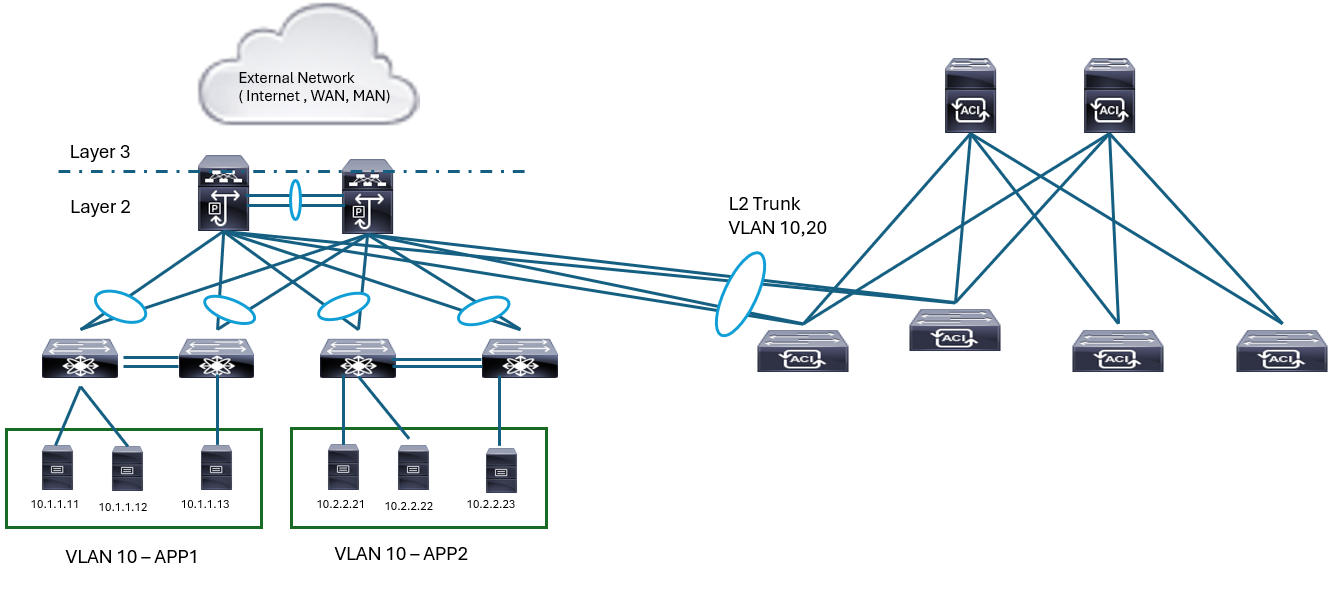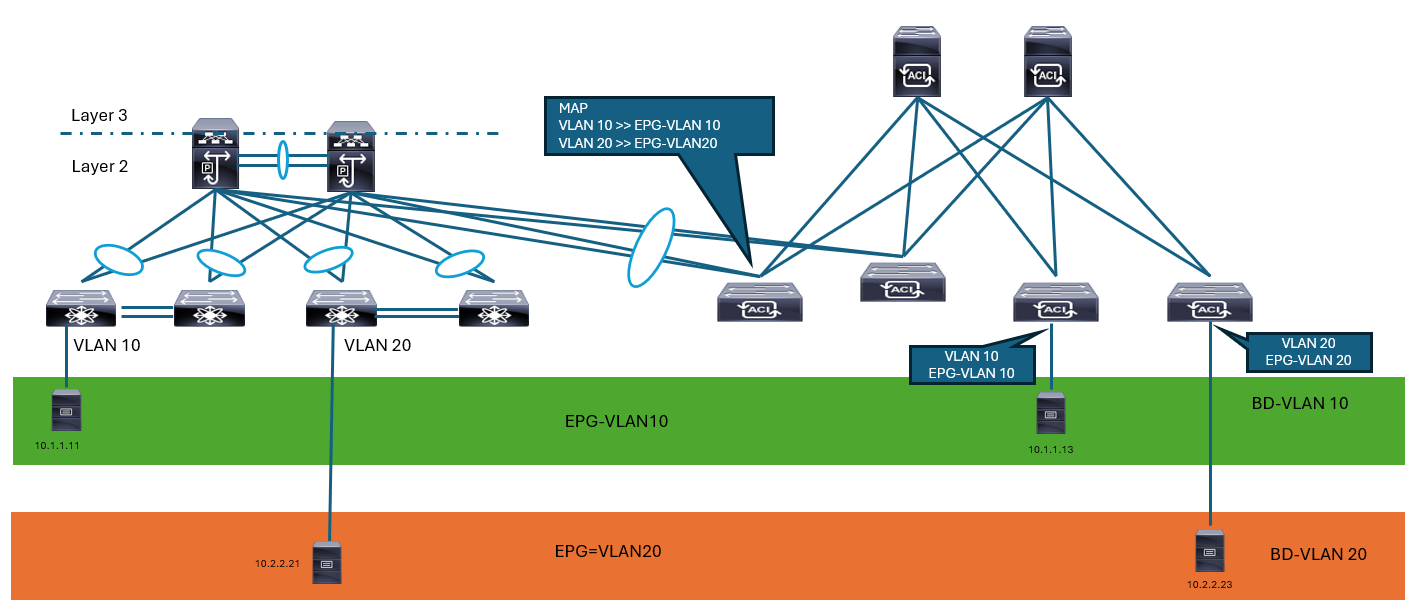EMAIL SUPPORT
dclessons@dclessons.comLOCATION
USMigrate Existing Network to ACI
The general methodology of migrating existing network to Cisco ACI fabric can be divided into three steps: deployment, integration, and migration.
The deployment step consists of Cisco ACI fabric design and implementation that includes activities such as:
- Selecting proper leaf and spine switches, Cisco APIC controllers.
- Bring up and initialize the Cisco ACI fabric with necessary operational and maintenance policies (NTP, DNS, syslog, firmware management, configuration management, and so on).
- Design how the network constructs should be configured in the Cisco ACI fabric such as:
-
-
BD (Layer 2 domain scope): How many subnets should one BD contain? How to map the current VLAN design into the ACI BD design and so on.
-
VRF (Layer 3 domain scope): Is VRF separation required? Should VRF route leaking be configured and so on.
-
-
Design how the policy (security) constructs should be configured in the Cisco ACI fabric such as:
-
EPG: Which applications should be able to communicate without a contract? What is the best EPG grouping to optimize contract configurations? Does EPG need to include applications with more than one subnet (related to how to design BD)? How should VLANs be allocated for each EPG and so on.
-
-
Design how the multi-tenancy should be configured in the Cisco ACI fabric such as:
-
Tenant: How should VRF, BD, EPG, and so on be logically grouped for the best operation/management.
-
Domain: How should VLANs and interfaces be allocated to each EPG, company organization or customer?
-
The integration step includes activities that are required to properly connect existing network with Cisco ACI fabric:
- Selecting and connecting interfaces on the side of the existing network and on the Cisco ACI fabric side.
- Implementing configuration on the Cisco ACI fabric side that may include extending Layer 2 domains or providing Layer 3 connectivity between the environments.
The migration step includes activities that are required to move the workloads from existing network to Cisco ACI fabric, which is typically the longest part of the migration process that may take several months to complete. The complexity and duration of this step is largely due to the requirement of no or minimum downtime. The activities here may include the following:
- Migrating whole clusters or individual servers to the Cisco ACI fabric.
- Migrating virtual workloads from old clusters that are connected to the existing network to new clusters that are connected to the Cisco ACI fabric.
- Moving default gateway function from existing network to Cisco ACI fabric.
- Migrating L4-7 network services, that is, service appliances like firewalls and load-balancers.
Connecting Existing Network to Cisco ACI
Once the Cisco ACI fabric is initialized and operational, the first step in the migration is to connect the existing network to the Cisco ACI fabric.
The existing network should be connected in redundant manner with at least two separate links originating from different switches terminating at different Cisco ACI leaf switches.
At the existing network, the interconnecting links should be placed either at the dedicated border switches or at the switches that are used to aggregate the connectivity of other switches in the topology. At the Cisco ACI fabric, the interconnecting links are connected to a pair of Cisco ACI leaf nodes. Such connectivity will be used to extend the VLAN segments from existing network. Therefore, the interconnecting links will be configured as 802.1Q trunks for the required VLANs.
 In the example, the interconnection is implemented in a fully redundant manner:
In the example, the interconnection is implemented in a fully redundant manner:
- Four interconnecting links are used and configured in a double-sided vPC—this ensures that all configured links are utilized and no STP loop is created via Cisco ACI fabric.
- In the existing network, a pair of links terminates at one or another aggregating spine switch.
- At the Cisco ACI fabric, two pairs of links terminate at two leaf switches.
- The vPC is configured as 802.1Q trunk for VLANs 10 and 20 (and other VLANs that need to be migrated from the existing network).
Migrating Workloads
To be able to migrate the workloads from existing network to Cisco ACI, the network segments where workloads are connected must also be implemented at the Cisco ACI fabric.
The simplest approach is to extend the existing segments using the same VLAN IDs as used in the existing network.
In the Cisco ACI, where endpoints are grouped based on EPGs and not VLANs, EPG for each segment to be migrated should be created. The interconnecting links should have all the EPGs statically mapped to the relevant existing VLANs. The interconnecting links must have EPGs and static mapping that is configured for all VLANs that need to be migrated. The individual ports at Cisco ACI leaf switches, where workloads are meant to be migrated, should also have required EPGs statically mapped to proper VLANs. Individual port may have multiple EPGs with static VLAN mapping assigned when it is connecting a virtualization host.
 In the example, workloads from VLAN 10 and 20 need to be migrated to the Cisco ACI fabric: the workloads from VLAN 10 belong to EPG-VLAN10 and those from VLAN 20 to EPG-VLAN20.
In the example, workloads from VLAN 10 and 20 need to be migrated to the Cisco ACI fabric: the workloads from VLAN 10 belong to EPG-VLAN10 and those from VLAN 20 to EPG-VLAN20.
The mapping in the Cisco ACI is done by creating BD and EPG per VLAN. You create BD-VLAN10, EPG-VLAN10, BD-VLAN20, and EPG-VLAN20. This approach is called Network-Centric Design.





LEAVE A COMMENT
Please login here to comment.